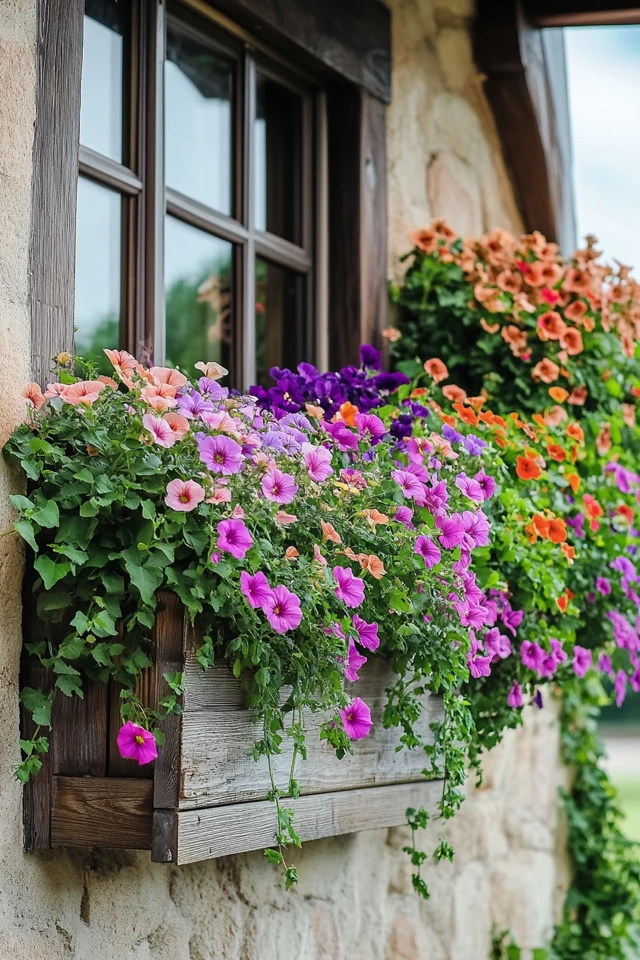Introduction
There’s something magical about a farmhouse-style home adorned with charming window boxes overflowing with vibrant blooms. Window boxes are more than just a decorative touch—they’re a statement of personality, a burst of life and color that elevates your home’s curb appeal. Whether you’re working with a rustic farmhouse, a modern cottage, or even an apartment balcony, window boxes can bring timeless charm and a cheerful vibe to any space.
I remember the first time I decided to install window boxes on my home. My front yard was tidy but lacked that spark of color and personality I’d always admired in farmhouse designs. After choosing the perfect wooden window boxes, I filled them with a mix of bright petunias, trailing ivy, and soft lavender. The transformation was instant—suddenly, my house felt warm, welcoming, and full of character. Each season, I’ve swapped out the plants to keep things fresh, and I love how they make my home stand out.
If you’re looking for a way to add charm and a pop of color to your farmhouse-style home, window boxes are the perfect solution. In this guide, we’ll explore the best ideas for styling your window boxes, tips for selecting the right plants, and how to make them a show-stopping feature of your home.
The Perfect Design for You
Farmhouse window boxes are ideal for anyone who wants to combine rustic charm with bursts of vibrant color. They add dimension and life to your home’s exterior while offering endless opportunities for creativity and customization.
The beauty of window boxes lies in their versatility. Whether you love the look of overflowing greenery, colorful blooms, or a mix of textures, you can tailor your design to suit your style. Imagine wooden boxes filled with bright geraniums, cascading vines, or fragrant herbs that sway gently in the breeze. From spring through fall, farmhouse window boxes bring warmth and character to your home while offering a fun way to embrace seasonal changes.
What’s more, they’re not just for homes with sprawling porches or large front yards. Even small spaces—like apartments or townhouses—can benefit from the charm of window boxes. With a little creativity, you can transform your home’s exterior into a farmhouse-inspired masterpiece.
Picture Gallery
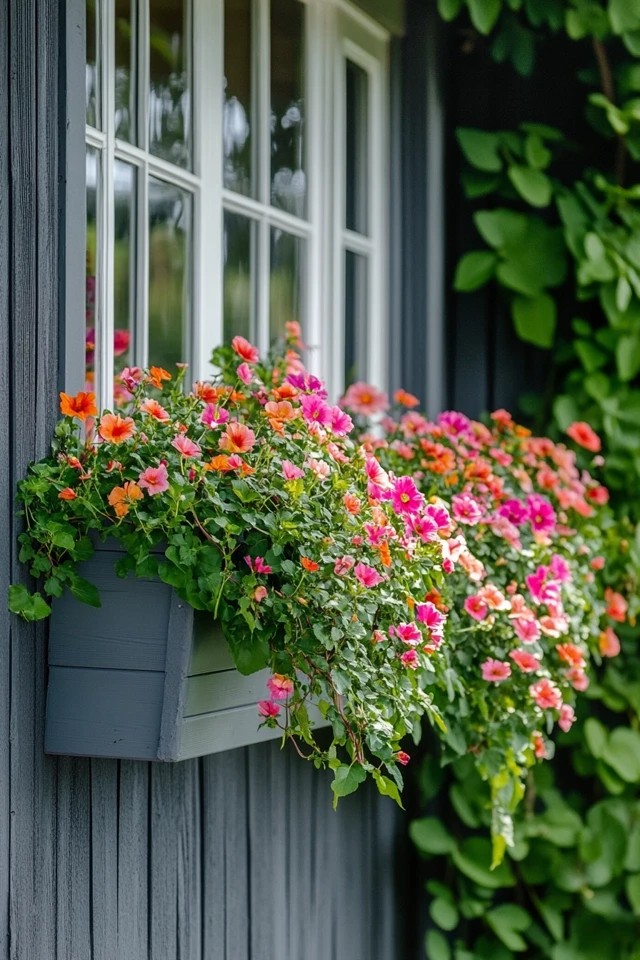
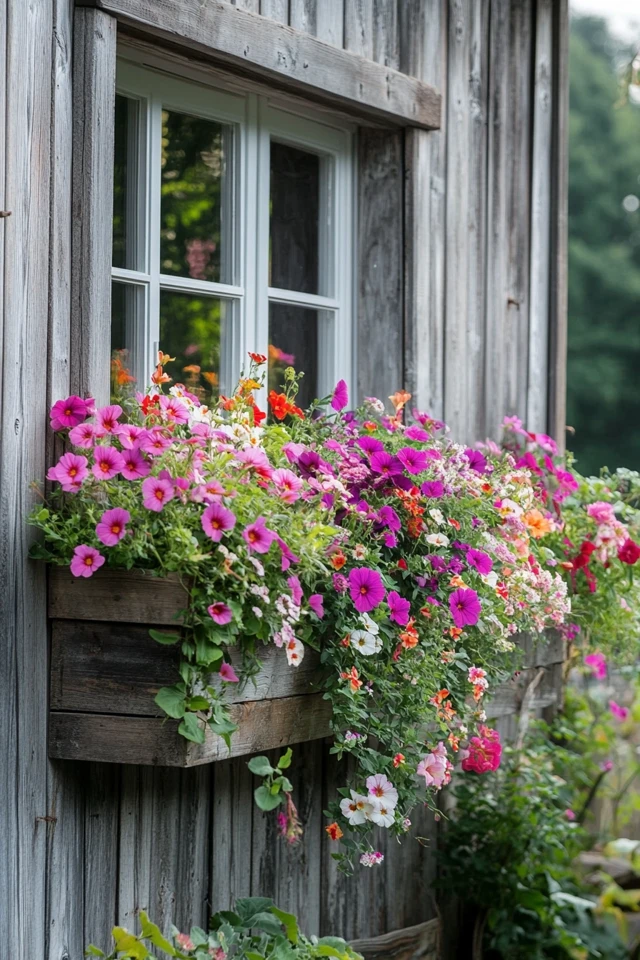
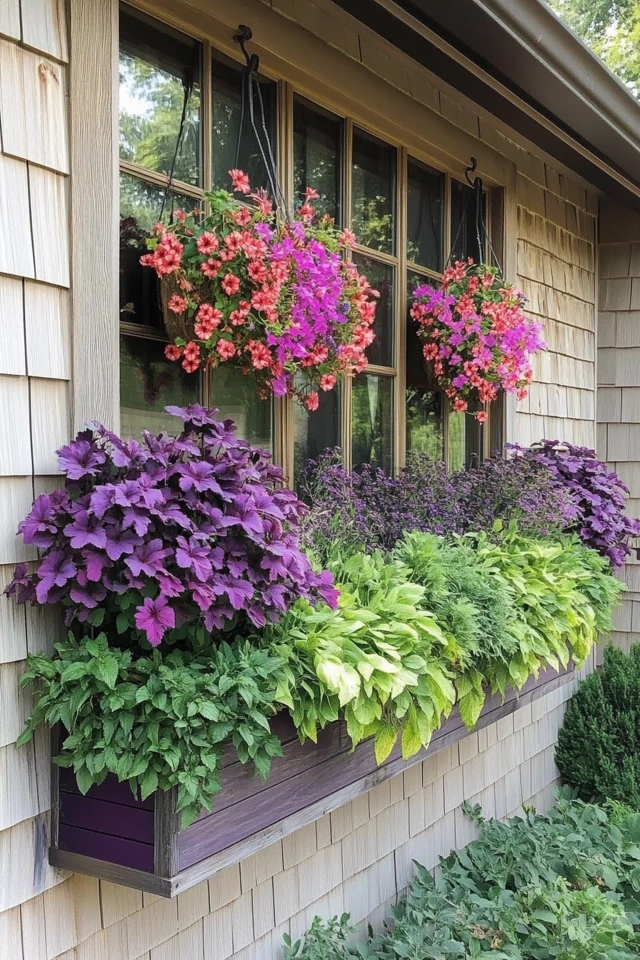
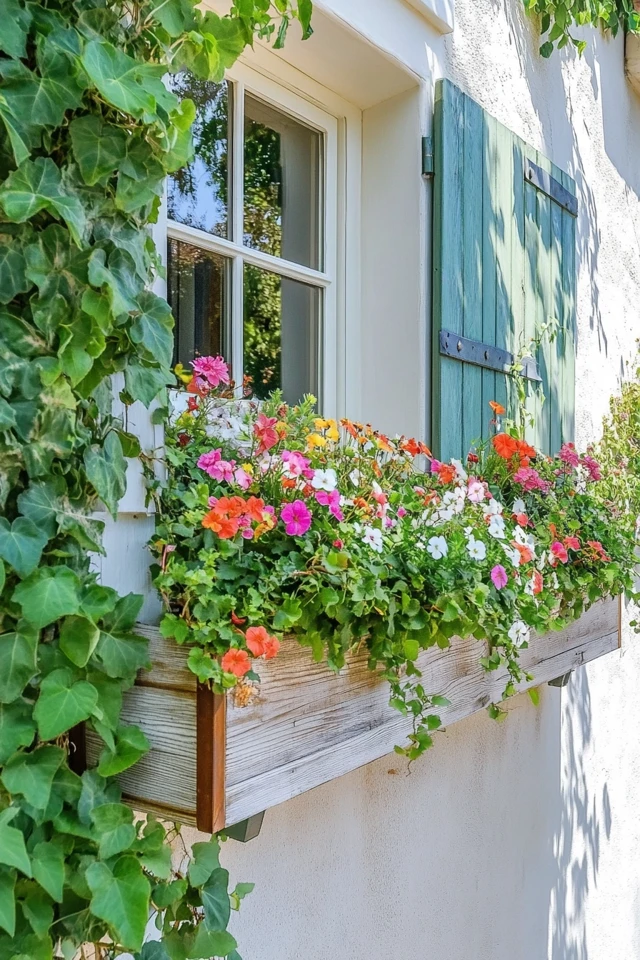
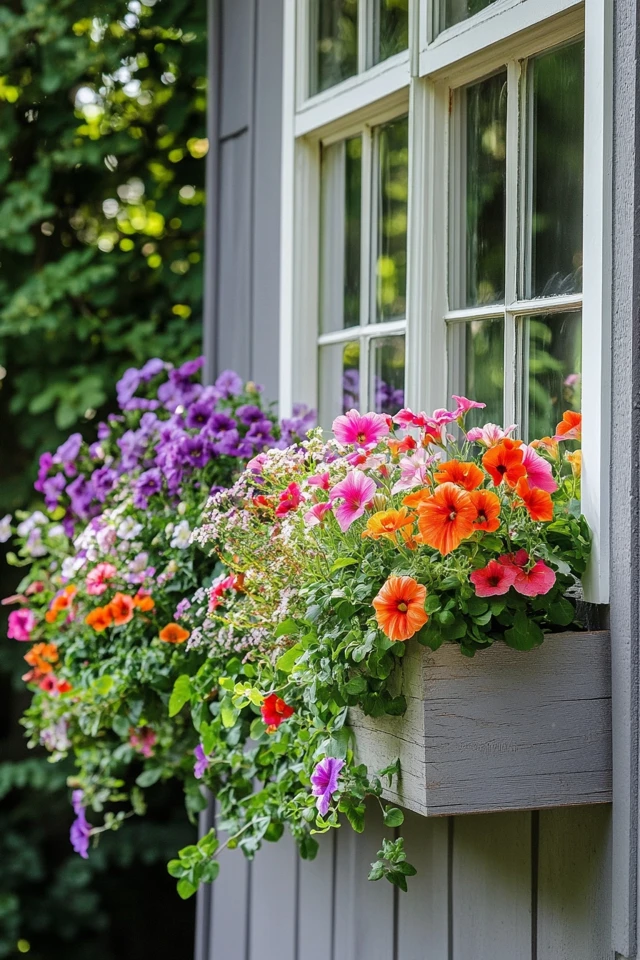
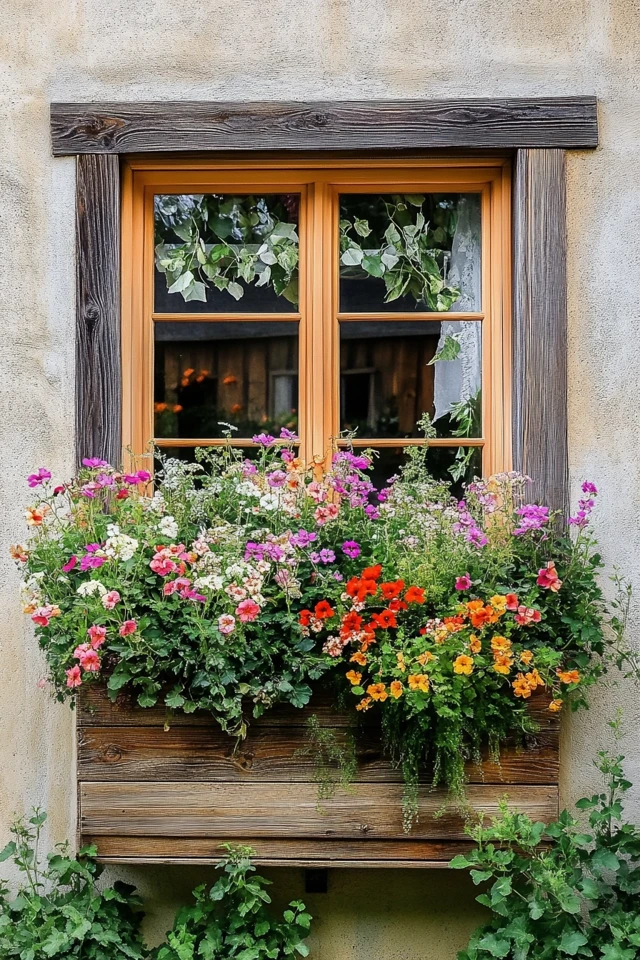
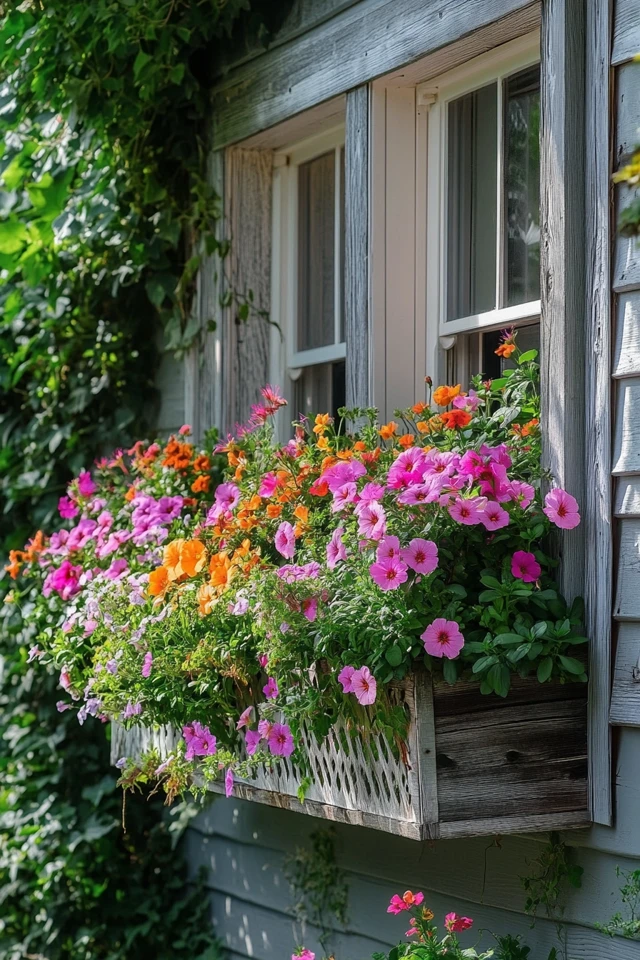
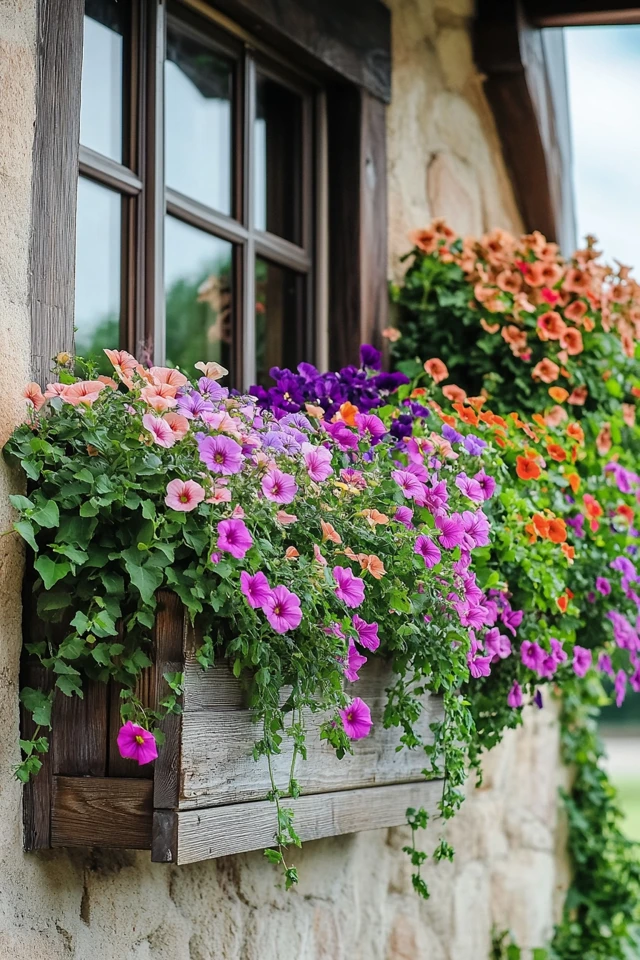
Why These Key Elements Work So Well Together
Farmhouse window boxes succeed because they combine practical functionality with eye-catching design. Here’s why the key elements of window boxes work so beautifully:
- Natural Materials: Wooden or galvanized metal boxes echo the rustic charm of farmhouse decor. They complement natural textures like wood siding, brick, or shiplap.
- Vibrant Colors: The contrast between neutral farmhouse exteriors and colorful blooms creates a stunning visual effect that draws the eye.
- Layered Textures: Mixing trailing vines, lush foliage, and bright flowers adds depth and dimension to your window boxes.
- Seasonal Versatility: Window boxes can be refreshed with seasonal plants and decor, making them a year-round feature.
- Curb Appeal Boost: These small additions can transform the look of your home, making it feel more inviting and polished.
The Best Farmhouse Window Box Ideas for a Pop of Color
1. Classic Wooden Boxes with Bright Flowers
- Choose weathered or whitewashed wooden boxes to embrace a classic farmhouse aesthetic.
- Fill them with bright blooms like red geraniums, pink petunias, or yellow marigolds for a cheerful burst of color.
- Add trailing plants like ivy or sweet potato vine to soften the edges.
2. Herb-Filled Window Boxes
- Opt for functional beauty by planting herbs like rosemary, thyme, basil, and lavender.
- Use natural wooden boxes or galvanized metal planters for a rustic farmhouse look.
- Pair herbs with small flowering plants like marigolds or nasturtiums for added color.
3. Overflowing Greenery
- For a lush, understated look, fill your window boxes with trailing greenery like ivy, ferns, or creeping Jenny.
- Pair with tall grasses or ornamental plants like coleus for added texture.
- Use darker stained wood or metal boxes for a striking contrast against the green foliage.
4. Seasonal Swaps
- Spring: Fill boxes with pastel flowers like pansies, tulips, and hyacinths. Add greenery like moss for a fresh look.
- Summer: Opt for bold, heat-tolerant blooms like petunias, zinnias, and calibrachoa.
- Fall: Use mums, ornamental cabbage, and trailing ivy. Add small pumpkins or gourds for seasonal flair.
- Winter: Fill boxes with evergreen branches, holly, and pinecones. Add twinkling lights or ribbons for holiday cheer.
5. Monochromatic Color Schemes
- Create a sophisticated look by sticking to one color palette. For example:
- Whites and greens: white petunias, dusty miller, and trailing ivy.
- Pinks and purples: lavender, geraniums, and creeping phlox.
- Choose plants with varying textures and heights to keep the arrangement dynamic.
6. Cottage Garden Style
- Go for a wild, overgrown look with a mix of flowers and greenery.
- Use colorful blooms like cosmos, snapdragons, and daisies alongside trailing plants like ivy or vinca.
- Pair with distressed wood or wrought iron boxes for a romantic farmhouse feel.
7. Galvanized Metal Boxes
- Use galvanized planters for a farmhouse-industrial vibe.
- Fill with hardy plants like succulents, ornamental grasses, or colorful annuals.
- Pair with white or grey house exteriors for a sleek, modern look.
8. Rustic Crates or Repurposed Containers
- Repurpose vintage crates, troughs, or other containers as unique window boxes.
- Fill with a mix of wildflowers or native plants for an organic, natural look.
- Add rustic details like rope handles or metal brackets for extra charm.
9. Vertical Gardening with Window Boxes
- Install stacked window boxes or tiered planters to create a vertical garden effect.
- Combine a mix of colorful flowers, trailing vines, and edible plants like strawberries or lettuce.
- Perfect for maximizing space on smaller exteriors.
10. Add Decorative Elements
- Incorporate farmhouse-style accents like wrought iron brackets, burlap liners, or chalkboard labels.
- Use small signs, lanterns, or fairy lights to add personality to your window boxes.
How to Maintain Farmhouse Window Boxes
- Choose the Right Plants:
- Consider sunlight and water needs based on the placement of your window boxes.
- Opt for hardy, low-maintenance plants if you prefer less upkeep.
- Water Regularly:
- Window boxes can dry out quickly, so water them frequently—especially during hot summer months.
- Fertilize for Growth:
- Use a balanced fertilizer to keep plants healthy and blooming.
- Prune and Deadhead:
- Remove dead leaves and spent flowers to encourage new growth and keep boxes looking tidy.
- Refresh with Seasons:
- Swap out plants and decor to match the season, keeping your window boxes fresh and vibrant year-round.
FAQ Section
1. Can I install window boxes on any type of house?
Yes! Whether you have wood, brick, or siding, you can find brackets or installation methods that work for your home. Make sure to use sturdy hardware for secure placement.
2. What are the best materials for window boxes?
Wood and galvanized metal are classic farmhouse choices. Wood offers a rustic look, while metal adds a modern industrial touch. Both are durable with proper care.
3. How do I prevent overwatering?
Choose window boxes with drainage holes to prevent waterlogging. Use well-draining soil and avoid overwatering plants.
4. Are window boxes suitable for all climates?
Yes! Select plants that thrive in your climate. You can also adapt window boxes with seasonal swaps to suit changing conditions.
5. How do I keep my window boxes secure?
Use heavy-duty brackets and screws to attach your window boxes securely. Make sure they’re level and check regularly for stability.
Variations
- Modern Farmhouse Window Boxes: Opt for clean lines, galvanized metal, and monochromatic plant arrangements.
- Coastal Farmhouse Window Boxes: Use whitewashed wood, blue blooms, and trailing greenery for a breezy, seaside vibe.
- Rustic Farmhouse Window Boxes: Choose weathered wood or repurposed crates and fill them with wildflowers and trailing vines.
- Industrial Farmhouse Window Boxes: Pair metal containers with hardy succulents and dark foliage for a sleek, edgy look.
- Whimsical Farmhouse Window Boxes: Incorporate unique touches like hanging teacups, fairy lights, or colorful patterns for a playful twist.
How to Showcase It
- Seasonal Photos: Take photos of your window boxes in each season to show off their changing beauty.
- Social Media Highlights: Share before-and-after shots of your farmhouse window box transformation.
- Host Gatherings: Use your vibrant window boxes as a backdrop for outdoor entertaining or photo ops.
Occasions to Feature It
- Spring Refresh: Welcome warmer weather with pastel blooms and lush greenery.
- Summer Celebrations: Add vibrant, heat-tolerant flowers for a cheerful summer vibe.
- Fall Festivities: Incorporate mums, pumpkins, and autumnal accents for a cozy touch.
- Winter Holidays: Decorate with evergreen branches, pinecones, and twinkling lights.
Conclusion
Farmhouse window boxes are a simple yet impactful way to add charm, color, and character to your home. Whether you prefer bright blooms, fragrant herbs, or lush greenery, there’s a window box style to suit every farmhouse aesthetic.
By choosing the right plants, materials, and accents, you can create window boxes that make your home stand out in every season. So grab your gardening gloves, get creative, and let your farmhouse window boxes become the perfect pop of color for your home!

